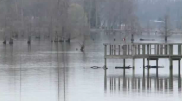Three Mile Island: A Brief History
On March 28, 1979, began to experience a partial core meltdown in Unit 2 of the Three Mile Island Nuclear Generating Station in Dauphin County.
Officials declared an onsite emergency after a reading showed 1,200 millirems two days after the accident. Pennsylvania put civil defense teams on alert to evacuate the surrounding area.
Low levels of radiation were detected up to 16 miles away from the site of the accident, yet state officials did not plan to evacuate the 15,000 people within a mile of the site. Crews worked in hour-long shifts to mop up radioactive water.
Metropolitan Edison Company (Met Ed) dumped 40,000 gallons of industrial waste water with radioactive Xenon into the Susquehanna river, and state officials quickly gave permission to dump 400,000 more. At this point, plant officials said the possibility of a meltdown was over.
The accident was predicted to cost Met Ed $1 million a day to buy electricity from other power companies.
On CBS Evening News with Walter Cronkite, The Nuclear Regulatory Commission said a meltdown was possible. A 15- to 25-foot wide trapped bubble of gas at the top of the reactor was causing the problem. If pressure was released, the bubble would expand, and could expose the reactor core to air.
We are faced with the remote but very real possibility of a nuclear meltdown at the three mile island atomic power plant.
Pregnant women and children within 5 miles were evacuated; 23 schools were closed. Citizens didn't panic, but believed they were not being told seriousness of situation. Plant officials predicted radiation would continue to leak for at least five days.
When Gov. Dick Thornburgh, President Carter and his wife visited site on April 1, the president declared the situation “stable.”
By April 2, the hydrogen bubble trapped in the reactor had shrunk, but it was unknown by how much. Workers started to convert the hydrogen gas back into water.
Soon afterward, President Carter increased the amount of surprise inspections to all nuclear power plants by 75 percent. As no federal inspector had been assigned to Three Mile before the accident, a new goal was set to have inspectors at all sites by 1981.
Energy Secretary Schlesinger was still optimistic: no lives had been lost in nuclear power so far.
By April 12, President Carter created an 11-person commission to investigate the accident, including a housewife from Middletown, Pa. and a University of Wisconsin sociology professor. The commission had a $1 million budget and findings would be presented after six months.
National discussions on atomic power suggested that it could become too costly and force itself out of the market. Some suggested that the accident would definitely end construction of plants near urban areas, in turn driving up transmission prices. Colo. Sen. Gary Hart said he feared the public would lose sight of pursuing safety in nuclear power.
On September 24, a "no nukes" rally drew 200,000 people in Manhattan, N.Y., featuring live music and participation by Pete Seeger, Jackson Browne, and Crosby, Stills and Nash. Tom Hayden and Jane Fonda also spoke at the event.
Elsewhere, protesters blocked the gate to Vernon Yankee power plant in Vernon, Vermont. Police arrested 167 people.
Time Magazine revisited Three Mile Island in March 1980, a year after the nuclear accident. The area looked much the same but locals said they would not forget what they went through. A week earlier, Met Ed made the first efforts to decontaminate the reactor. The real estate market was unchanged; retail had boosted due to more plant workers and tourism. Some local workers were optimistic about the future of nuclear power.
The first stage of the cleanup finished in 1990, with 150 tons of radioactive material shipped to be stored in Idaho.
Fourteen years later, the estimated $1 billion cleanup was finally completed. The last two years was dedicated to getting rid of 2.23 million gallons of toxic water.
In 2009, locals spoke to the Pittsburgh Tribune-Review about their experience with the disaster. One woman said that just two hours after the accident, “the air smelled and tasted like metal.” Then-Mayor Robert Reid recalled townspeople clearing out. He since decided to keep a Geiger counter in his office to read radiation.
Three Mile Island still functions, but has changed to symptom-based operating systems from system-based operating systems in response to the accident.
Locals still remain cautious long after the accident, stocking potassium iodine, keeping updated evacuation routes, and other preparations.
In 2011, Japan’s accident brought back memories of Three Mile Island, though many said it was not as bad as Fukushima.
Some locals said they didn’t always like living near the plant, but have accepted it. Others actively protest nuclear power. They organize every March 28 at 4 a.m. (the date and time of original accident) in front of the plant.





